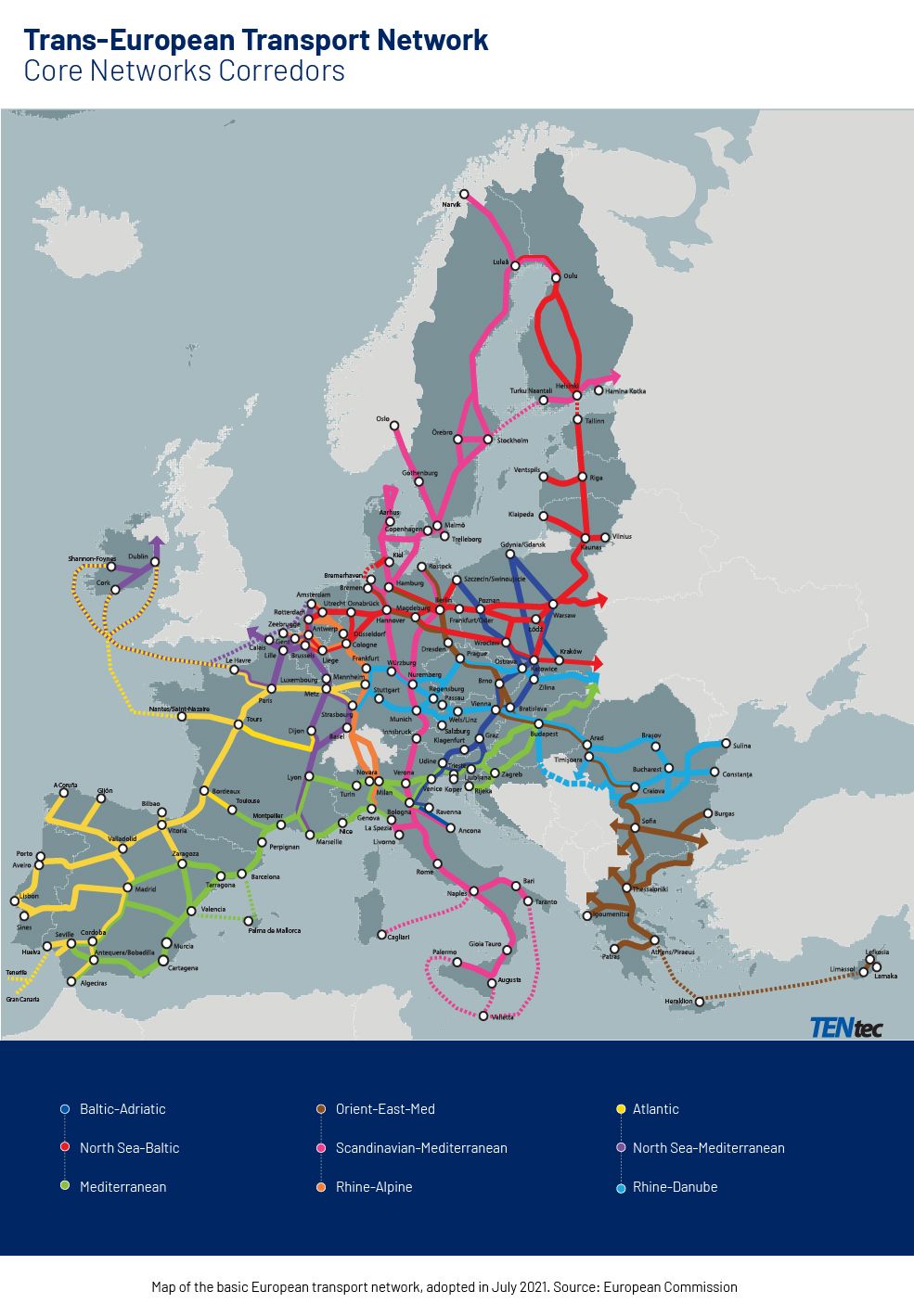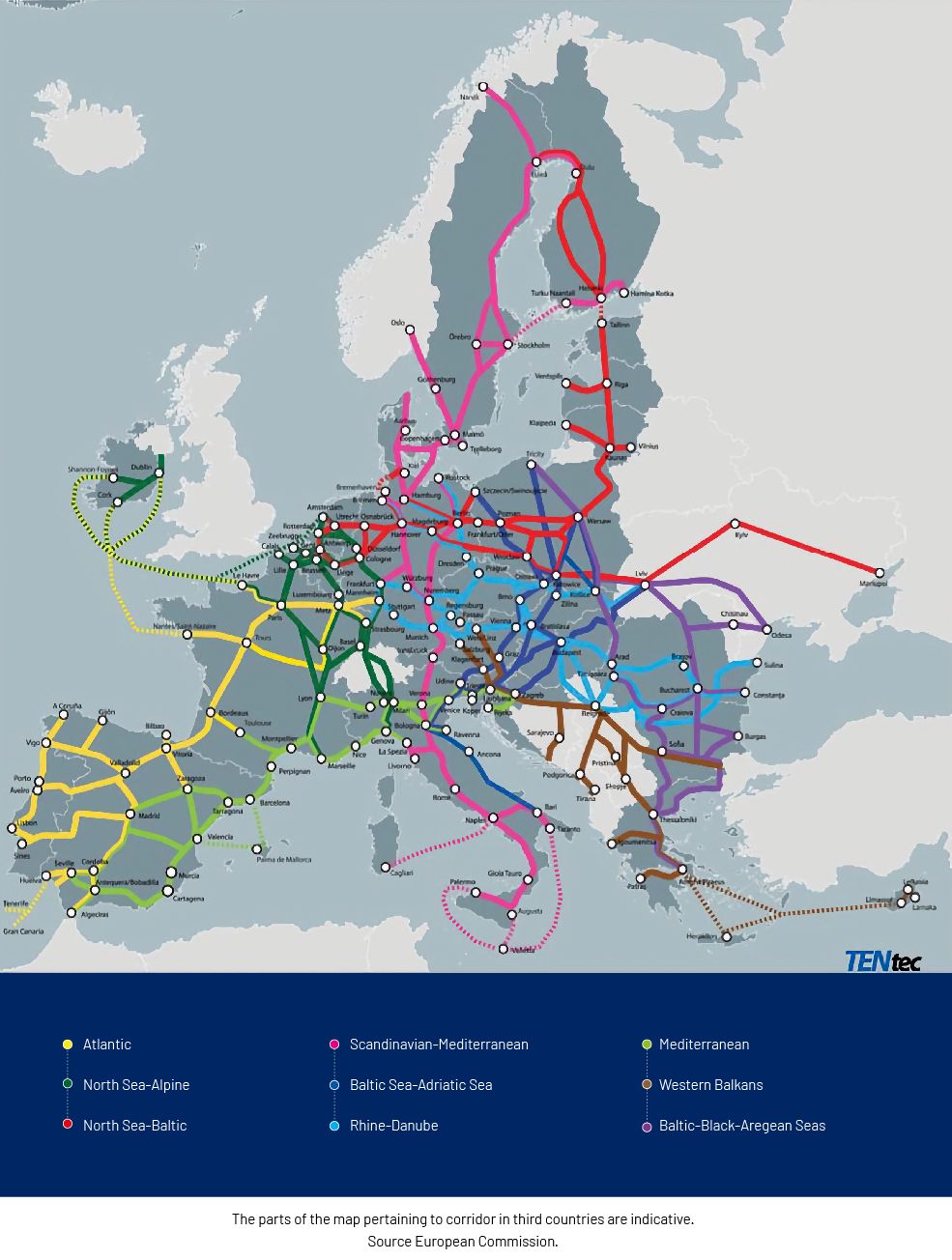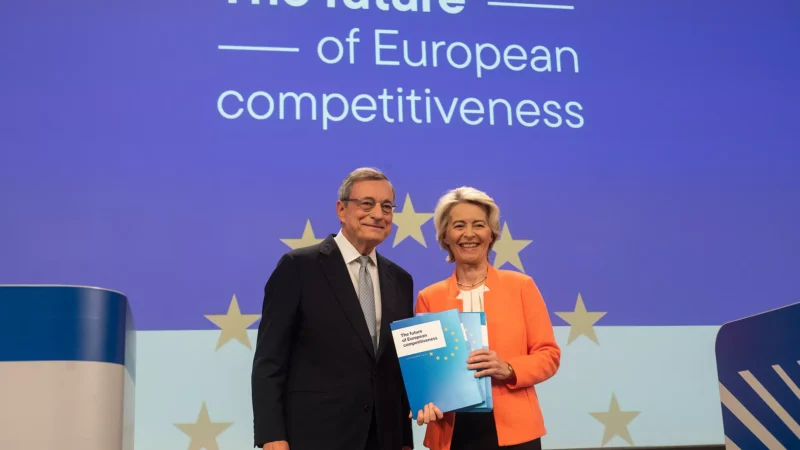 In July 2022, the Commission revised the TEN-T maps to facilitate the extension of the European corridors to Ukraine and their future incorporation into European transport standards. (GettyImages)
In July 2022, the Commission revised the TEN-T maps to facilitate the extension of the European corridors to Ukraine and their future incorporation into European transport standards. (GettyImages)
The Trans-European Transport Network extends to the East
This is one of the consequences of the conflict between Russia and Ukraine. The approval in July 2021 of the revision of the Trans-European Transport Network (TEN-T) has been made contingent on the war and a modification is underway. We explain its main points.

Carles Rúa is the Chief Innovation Officer at the Port de Barcelona and Director of the Master’s degree in Executive in Supply Chain Management at the UPC.
 In July 2022, the Commission revised the TEN-T maps to facilitate the extension of the European corridors to Ukraine and their future incorporation into European transport standards. (GettyImages)
In July 2022, the Commission revised the TEN-T maps to facilitate the extension of the European corridors to Ukraine and their future incorporation into European transport standards. (GettyImages)
The purpose of the TEN-T
EU Regulation 1315/2013 is the framework for the development of the Trans-European Transport Network (TEN-T). It was created with the aim of establishing a multimodal transport network to link the transport flows of people and goods across Europe.
This network links the EU's urban nodes with sea and river ports, airports and intermodal terminals, through a structure of roads, railways and motorways of the sea.
This regulation established the European transport network in two layers:
- A comprehensive network: the set of existing and planned infrastructures covering all regions of the EU. It includes measures to promote an efficient, socially and environmentally sustainable use of this infrastructure.
- A core network: the parts of the overall network that are strategically important for achieving European transport objectives.
The regulation established provisions for the core network to be completed by 2030 and the comprehensive network by 2050.
This structure was deployed through nine European transport corridors, the Core Network Corridors (CNC), and two horizontal priorities: the European Rail Traffic Management System (ERTMS) and the aforementioned Motorways of the Sea.
The changes to the TEN-T
However, the disruptions caused by the COVID-19 pandemic and the current challenges facing the EU (climate change, energy transition, the need to develop more resilient infrastructure), triggered a revision of the legal framework in July 2021.
Regulation (EU) 1153/2021 is aligned with the new objectives of the European Green Deal and the Sustainable and Smart Mobility Strategy.
The new proposal has significant changes compared to the previous one:
- It creates the concept of the European Transport Corridors (ETC), which merges the nine Core Network Corridors (CNC) with the Rail Freight Corridors (RFC) also defined by the EU.
The aim is to ensure the correct constructive development of the infrastructures and the coordination of their operation. - It adds the Extended Core Network to the two existing layers, the development of which should be completed by 2040. In terms of funding, this new layer will have the same opportunities as the core network.
- The definition of 'urban node' is relaxed. All urban areas with more than 100,000 inhabitants and the capitals of NUTS2 regions where there are no nodes of this dimension become part of the network. This brings the number of urban nodes in the EU from 88 to 426.
- The concept of motorways of the sea, which was very restrictive in the previous regulation, is replaced by the concept of the European Maritime Space. It includes not only routes between EU ports, but also with neighbouring countries.
- It clearly sets the reduction of greenhouse gas emissions as one of the objectives of this revision. It also promotes the design of infrastructures that ensure resilience and climate neutrality.

How the Russia-Ukraine war enters the TEN-T
Unfortunately, Russia's recent invasion of Ukraine has forced the European Union to rethink the trans-European transport network based on the new geopolitical landscape.
Thus, in May 2022, the European Commission identified the main challenges facing the EU and neighbouring countries to support Ukraine's economy and recovery and improve its communications with EU countries by extending the European Transport Corridors.
Indeed, this May, as part of the EU's solidarity response to Ukraine, the European Commission presented a set of actions to facilitate the export of its agricultural products through the so-called "Solidarity Lanes" Communication.
This document proposes a series of urgent measures to be developed:
- Increase the available transport material (wagons, ships,...).
- Increase rail capacity (number of train paths, access and capacity of intermodal terminals, etc.).
- Facilitate administrative processes for border-crossing (customs formalities).
- Increase storage capacity on European soil for Ukrainian agricultural products.
In the medium term, the communication wants to establish new connecting infrastructures that will help the reconstruction of Ukraine.
In this regard, in July 2022 the Commission revised the TEN-T maps to facilitate the extension of the European corridors to Ukraine and their future incorporation into European transport standards.
The recent invasion of Ukraine has forced the European Union to rethink the Trans-European Transport Network based on the new geopolitical landscape.
The new TEN-T map
The main changes proposed, to yet be approved by the European Parliament, are the extension of four of the European Transport Corridors to Moldova and Ukraine.
In particular, it proposes:
- Extend the North Sea - Baltic Sea corridor through Lviv and Kyiv to Mariupol.
- Extending the Baltic Sea - Black Sea - Aegean Sea corridor to Odessa via Lviv and Chisinau.
- The extension of the Baltic Sea - Adriatic Sea and Rhine-Danube corridors as far as Lviv.

On the other hand, these proposals imply a reduction in the length of the Mediterranean Corridor. Until now, it reached the Ukrainian border via Hungary. In the new maps defined by the EU it ends in Zagreb (Croatia).
In addition to adapting the corridors, other measures are proposed:
- Bringing the infrastructure in Moldova and Ukraine up to European technical, regulatory and administrative standards. This will require very considerable investments.
- Russia and Belarus are no longer a priority target for the EU. As a consequence, cross-border crossings between the EU and these two countries are no longer part of the Core Network but are included in the Comprehensive Network, and therefore their implementation is delayed from 2030 to 2050. In practical terms, this has a considerable impact on the financing of cross-border infrastructure, as European funds are directed preferentially towards the Core Network.
- Maps indicating the possible future extension of the TEN-T towards Russia and Belarus are removed from the TEN-T. This point leaves the door open to a possible democratic transition in Belarus, which could allow its reincorporation into the Regulation.
- Member States are required to draw up plans for adaptation to standard gauge. Finland, Estonia, Latvia, Lithuania, Portugal and Spain, member states with a nominal track gauge other than 1435 mm, will have to draw up a plan for the transition of their railway infrastructure to the European standard gauge. These plans (but not the infrastructure) will have to be finalised two years after the adoption of the new regulation.
Although it also has a different gauge, Ireland is excluded because being an island doesn’t connect to the rest of the European rail infrastructure.
The adoption of a standard gauge in Moldova and Ukraine, as well as in the other European countries, is essential to improve rail interoperability and efficiency.
This proposed amendment joins other initiatives developed by the EU to facilitate exports and bilateral trade between the EU and Ukraine. The spill-over effects of the conflict also reach transport.





